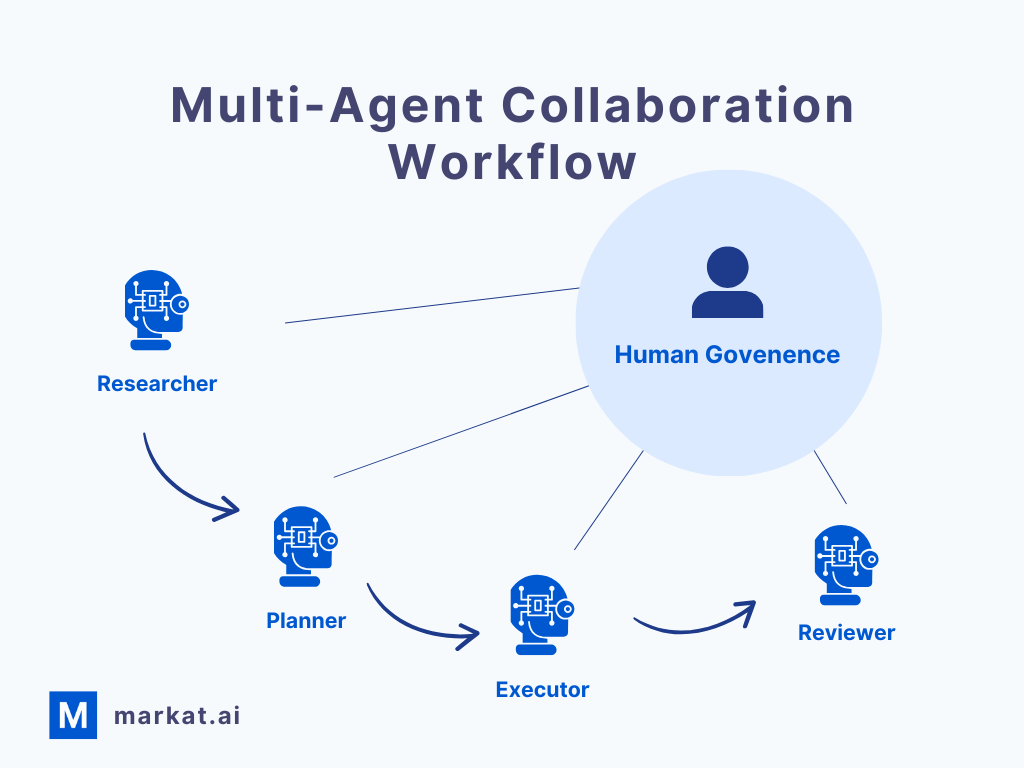The real power of AI isn’t in single agents working alone. It’s when multiple agents collaborate, each with a defined role, moving the work forward together. This shift is what’s making workflows faster, more reliable, and closer to how real teams operate.
Multi-agent systems are not a future concept. They’re already being tested in industries like healthcare, engineering, and finance. The results show that when agents collaborate, businesses save time, reduce errors, and scale without needing more headcount.
If you’re new to this space, it helps to first understand what an AI agent is and why it’s different from a tool.
What Is Multi-Agent Collaboration in AI?
Multi-agent collaboration means autonomous agents coordinating like a team. Each agent has a role, and together they handle an entire workflow.
- One agent gathers data.
- Another drafts a report.
- A third reviews for compliance and accuracy.
The outcome is a finished deliverable, not just a single task.
This builds on the difference we outlined in AI agents vs AI tools. Agents aren’t single-use helpers; they’re part of a system.
Real-World Applications
- Healthcare: Agents summarize patient notes, validate against medical guidelines, and prepare insurance-ready documentation.
- Architectural engineering: Agents run structural analysis, check compliance codes, and assemble client-facing reports.
- Customer service: Agents triage tickets, draft replies, and escalate only when needed.
- Finance: Agents reconcile expenses, detect anomalies, and flag risks.
These workflows are already showing measurable impact for small and mid-sized businesses.
Benefits and Pitfalls of Multi-Agent Collaboration
| Benefits | Pitfalls |
|---|---|
| Faster end-to-end workflows | Complexity: more agents mean more moving parts |
| Fewer errors through peer-checking | Integration challenges with legacy systems |
| Scalability without extra headcount | Governance: decisions need oversight |
| 24/7 operation | Automating broken processes leads to faster chaos |
| Security and ethics: poor design can mishandle data or introduce bias |
How Multi-Agent Systems Work
Multi-agent collaboration requires structure:
- Clear roles: Researcher, planner, executor, reviewer.
- Shared memory: Agents pass context seamlessly.
- Feedback loops: Agents validate each other’s work.
- Defined protocols: Rules and APIs keep interactions on track.

How to Get Started
- Pick one workflow. Focus on a process that is repetitive and structured.
- Test in a sandbox. Watch how agents interact before going live.
- Measure results. Look at hours saved, accuracy, or cost reduction.
- Refine. Adjust prompts, data, or roles.
- Scale carefully. Expand only after one success.
FAQ
What is multi-agent collaboration in AI?
It is when multiple AI agents coordinate roles and tasks to complete an entire workflow, instead of handling isolated actions.
What are the benefits of multi-agent collaboration?
They save time, reduce errors, and scale operations without adding more people.
What are the risks of multi-agent collaboration in business workflows?
Complexity, weak integration, governance gaps, and security or ethical risks are the biggest pitfalls to watch for.
How can small businesses implement multi-agent AI systems?
By starting with one workflow, such as documentation, reporting, or customer service, and testing collaboration before scaling.
Can AI agents replace employees?
No. Agents can take on repetitive workflows, but AI agents still need human governance to ensure their work is accurate, ethical, and aligned with business goals.
Conclusion
Multi-agent collaboration isn’t about piling on more AI. It’s about creating systems that work together the way real teams do. The benefits are clear, but so are the risks.
It’s important to remember that AI agents still need human governance. Their outputs must be checked, refined, and optimized. The businesses that treat agents as teammates, not replacements, will capture the most value.
At Markat.ai, we’re building a marketplace where developers and businesses can find these solutions, test them, and scale what works in real-world environments.


Leave a Reply